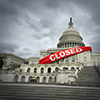 (Sept. 25, 2025) - As the calendar turns to fall, government shutdown talk is reemerging as the preeminent issue facing Congress. Federal fiscal year 2025 ends Tuesday, Sept. 30. Although appropriators made significant progress in reporting most of the annual spending bills from their committees, a pathway forward for final passage of a budget deal did not emerge during the first half of September.
(Sept. 25, 2025) - As the calendar turns to fall, government shutdown talk is reemerging as the preeminent issue facing Congress. Federal fiscal year 2025 ends Tuesday, Sept. 30. Although appropriators made significant progress in reporting most of the annual spending bills from their committees, a pathway forward for final passage of a budget deal did not emerge during the first half of September.
The House has reported all twelve spending bills from committee and passed three. The Senate has reported eight spending bills from committee and has passed three. There is talk of House and Senate leadership establishing a conference committee for resolving differences in an undefined set of bills, but this hasn't happened yet considering the path forward for the entire budget remains unclear.
In order to avoid a government shutdown next week, Congress must pass a continuing resolution funding the government at FY 2025 levels for a period of time. The question haunting Congress right now is the time period of the CR last and what anomalies, additional spending items not part of the base budget will be included. Health care policy features prominently in this debate.
The inclusion of health care extenders, Disproportionate Share Hospital cut waivers and Medicare Dependent Hospital, Low Volume Hospital and home health and telehealth extensions remains vital. However, the debate centers around the extension of the health care marketplace's enhanced premium tax credit. Set to expire on Dec. 31, 2025, as opposed to Sept. 30, 2025, the Kansas Hospital Association and other provider groups seek an extension included in the CR so it doesn't end up as a political tool potentially paired with health care cuts in a future year-long CR or omnibus bill.
Republicans have proposed a CR that would expire on Nov. 21, while Democrats have proposed a CR that would expire on Oct. 31 and include the EPTCs. Senate Republicans will not be able to pass a CR without Democratic help in getting the necessary sixty votes. So, the negotiations are the hammer, and the potential government shutdown next week is the anvil.
There is also the prospect of the proposal of a health care package in one chamber or the other this fall. Items on the table that we continue to watch closely from a defensive posture are site-neutral payment schemes and manufacturer-led 340B reforms that undermine the intent of the program. On the offensive side, one issue where we hope to see movement on is a Rural Emergency Hospital 2.0 bill that would address key priorities for existing REHs, those who may have an interest in converting, including to open up Critical Access Hospital reversion with necessary provider designations, as well as the ability to reopen recently closed hospitals as REHs.